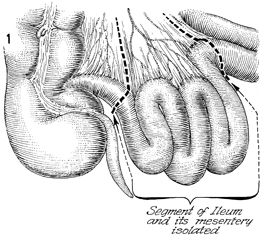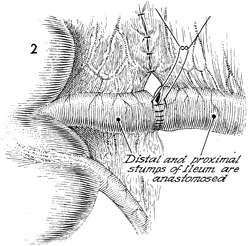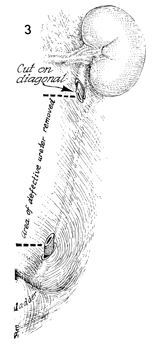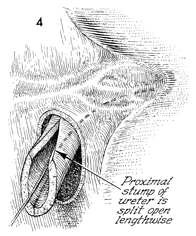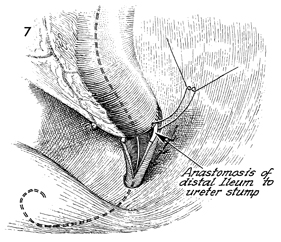|
||||||||||
Insertion of Suprapubic Catheter Retropubic
Urethropexy: Ureteroneocystostomy Transperitoneal Intestinal
Loop |
Ureteroileoneocystostomy When a large segment of the ureter must be excised as a result of radiation stenosis and/or chronic ureteritis, it is unwise to try to anastomose the remaining stenosed, radiated, and inflamed ureter to the bladder. Therefore, if the patient's kidney is reasonably healthy, the surgeon may choose among three procedures: (1) a cutaneous nephrostomy, (2) a transureteroureterostomy, and (3) a ureteroileoneocystostomy. This last procedure has the advantage of using nonirradiated materials in the entire system. Physiologic Changes. The most important physiologic changes are that (1) obstruction is taken away from the ureter and (2) the kidney is allowed to survive. The loss of a 10-15 cm segment of terminal ileum has few long-term sequelae. If a longer portion of the ileum is removed, however, vitamin B12 should be administered systemically. Points of Caution. All diseased ureter should be removed. The anastomosis of ileum into the renal tract can be made from the renal pelvis, along the ureter, down to the bladder. Frequently, this is unnecessary, as the proximal portion of the ureter coming off the renal pelvis may be nonirradiated and noninflamed. As in all cases of ureteral surgery, the ureter should be stented with medical grade Silastic double-J catheters. Technique
|
|||||||||
Copyright - all rights reserved / Clifford R. Wheeless,
Jr., M.D. and Marcella L. Roenneburg, M.D.
All contents of this web site are copywrite protected.

